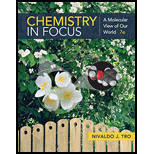
Interpretation:
The steps that should be taken to minimize the intake of lead from tap water are to be determined.
Concept Introduction:
Water is a common liquid that is present on the Earth.
It is also known as universal solvent. It can dissolve a wide range of organic and inorganic solutes.
Water is vital for the existence of all living animals. Without water, no life form can exist, it constitutes an important part of rivers, lakes, streams, clouds, snow and ice.
Water is truly an unusual molecule such that being a low molar mass compound, it exists as a liquid at room temperature and has an anonymously high boiling point.
Ice floats on water because it has a lower density than water.
Water contains some unwanted particles which can lead to diseases and other hostile effects on human health.
Numerous types of micro-organisms such as bacteria are present in water, which contaminate the water.
Biological contaminants: Some microbes can live in water and can cause various diseases like cholera, dysentery, and so on. Two examples of such microbes are Giardia and Legionella.
Inorganic contaminants: Some inorganic molecules can dissolve in water and make it impotable (not suited for drinking). Two examples of such molecules are Nitrates and Asbestos.
Organic contaminants: Some organic molecules can dissolve in water and makes it impotable (not suited for drinking). Two examples of such molecules are chlorohydrocarbons (volatile) and ethylbenzene (non-volatile).
Radioactive contaminants: Some radioactive elements can dissolve in water and make it impotable (not suited for drinking). Two examples of such elements are Uranium and Radium.
Contaminants that pose immediate health risks are the biological contaminants and inorganic contaminants because they get immediately dissolved in blood and starts reacting with it.
Contaminants that can be eliminated by boiling are the biological contaminants because the microbes can be killed by increasing the temperature.
Hot water dissolves lead more than cold water does.
Want to see the full answer?
Check out a sample textbook solution
Chapter 12 Solutions
Chemistry In Focus
- The proportion of O, C and H in the graphite oxide is constant, only the cantidades of functional groups of acids, phenols, epoxy, etc. its constants. ¿Is it correct?arrow_forwardThe proportion of O, C and H in the graphite oxide depends on the structure of the graph that is processed, which may be more tridimensional or with larger crystals, or with smaller crystals and more borders. ¿Is it correct?arrow_forwardIn mixed oxides with superconducting properties, we find Cu:a) Frequentlyb) Alwaysc) Almost neverarrow_forward
- The proportion of O, C and H in the graphite oxide depends on the preparation method, as long as the most oxidant, the most graphite is destroyed and has less O. Is it correct?arrow_forwardWrite the complete common (not IUPAC) name of each molecule below. Note: if a molecule is one of a pair of enantiomers, be sure you start its name with D- or L- so we know which enantiomer it is. molecule C=O H3N CH3 common name (not the IUPAC name) H ☐ C=O H O-C-CH2-CH2 010 NH3 ☐ H3N ☐ HO 5arrow_forwardWrite the systematic name of each organic molecule: structure CI CH3 HO-C-CH-CH-CH2 – CH— CH3 CH3 name X O ☐ CH3-CH-CH2-CH2-C-OH CH3 11 HO-C-CH-CH2-OH CH3 ☐arrow_forward
- Check the box under each a amino acid. If there are no a amino acids at all, check the "none of them" box under the table. Note for advanced students: don't assume every amino acid shown must be found in nature. CH3 CH2 0 C=O + CH-CH3 H₂N C-COOH H₂N H H H3N C COO¯ NH, O HO C C H CH3-CH HO C=O H2N-CH-COOH CH2 NH3 HO CH3 none of them O NH3arrow_forwardhandwritten answer please!arrow_forwardConsider the following SN 2 reaction: مار + Br H₂O acetone + Br OH What effect would each of the following changes have on the rate of this reaction. Select the single best answer for each part. Part 1 of 3 If the substrate was changed to: The rate would Br O increase O decrease O remain unchanged Part 2 of 3 × S If the nucleophile was changed to OH, the rate would: O increase O decrease O remain unchanged Part 3 of 3 If the solvent was changed to ethanol, the rate would: Increase O decrease O remain unchanged 2 ol Ararrow_forward
- Consider the following nucleophilic substitution reaction. The compound listed above the arrow is the solvent for the reaction. If nothing is listed over the arrow, then the nucleophile is also the solvent for the reaction. Part: 0/2 Part 1 of 2 Br acetone + I What is the correct mechanism for the reaction? Select the single best answer. OSN 1 OSN 2 X Part: 1/2 Part 2 of 2 Draw the products for the reaction. Include both the major organic product and the inorganic product. If more than one stereoisomer is possible, draw only one stereoisomer. Include stereochemistry where relevant. Click and drag to start drawing a structure. Х 5 ☐arrow_forwardTriethyloxonium tetrafluoroborate reacts with ethanol (CH3CH2OH) to give diethyl ether (CH3CH2OCH2CH3). BF triethyloxonium tetrafluoroborate Which equation, including the curved arrows, best represents the rate-determining step in the mechanism? Select the single best answer. O OH CH3CH2 OH + H. 0+ CH₂H₂ :0 + 0+ ж + H + :0: 0 Carrow_forwardCH3CH2CH=CH2 + H₂O − H+arrow_forward

 Chemistry: The Molecular ScienceChemistryISBN:9781285199047Author:John W. Moore, Conrad L. StanitskiPublisher:Cengage Learning
Chemistry: The Molecular ScienceChemistryISBN:9781285199047Author:John W. Moore, Conrad L. StanitskiPublisher:Cengage Learning Chemistry for Today: General, Organic, and Bioche...ChemistryISBN:9781305960060Author:Spencer L. Seager, Michael R. Slabaugh, Maren S. HansenPublisher:Cengage Learning
Chemistry for Today: General, Organic, and Bioche...ChemistryISBN:9781305960060Author:Spencer L. Seager, Michael R. Slabaugh, Maren S. HansenPublisher:Cengage Learning- Chemistry: Matter and ChangeChemistryISBN:9780078746376Author:Dinah Zike, Laurel Dingrando, Nicholas Hainen, Cheryl WistromPublisher:Glencoe/McGraw-Hill School Pub Co
 Chemistry by OpenStax (2015-05-04)ChemistryISBN:9781938168390Author:Klaus Theopold, Richard H Langley, Paul Flowers, William R. Robinson, Mark BlaserPublisher:OpenStax
Chemistry by OpenStax (2015-05-04)ChemistryISBN:9781938168390Author:Klaus Theopold, Richard H Langley, Paul Flowers, William R. Robinson, Mark BlaserPublisher:OpenStax





